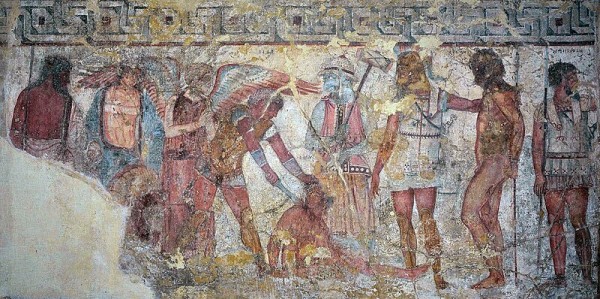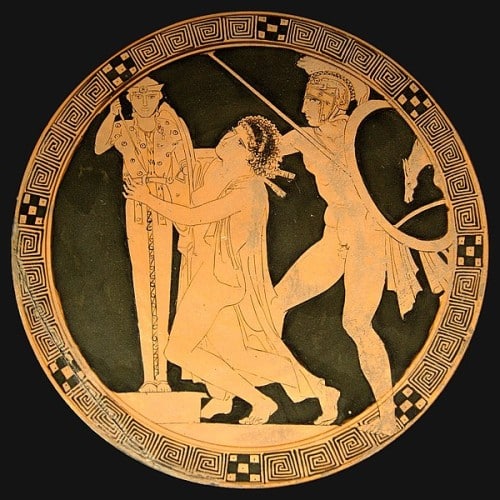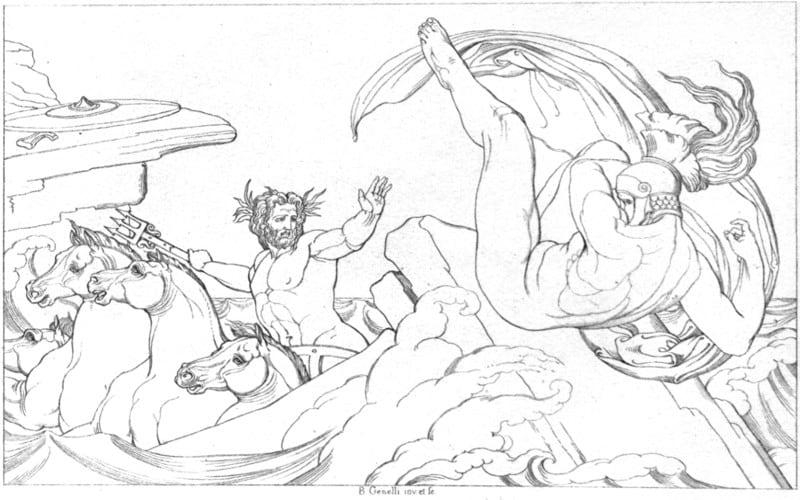Ajax the Lesser, also known as Locrian Ajax, was one of the most prominent Achaean warriors who fought in the Trojan War. Overshadowed by the more celebrated Ajax the Greater, Ajax the Lesser ended up being best known for his sacrilegious acts during the war. Locrian Ajax came from a proud and noble lineage, but his arrogant defiance of the gods resulted in a tragic outcome. Let’s find out more about the legacy and story of Ajax the Lesser.
Ajax the Lesser Key Facts
| Parents | Oileus and Eriope |
| Partners | none |
| Siblings | Medon |
| Offspring | none |
| Other names | Locrian Ajax, Oilean Ajax |
| Greek name | Αἴας ο Λοκρός |
| Roman name | Aivas Vilates |
| Best Known Myths | Violation of Cassandra, Suitor of Helen, Ajax and Poseidon (Death of Ajax) |
Name and Etymology
Ajax the Lesser was a name used to distinguish the hero from Ajax the Greater, who was the son of Telamon. The name Αἴας may derive from the verb αἰάζω which means “to sigh” or “to mourn”. Another etymology associates the name with the earth, meaning “of the earth”.
Ajax the Lesser was also known as Locrian Ajax and Oilean Ajax. The epithet Locrian refers to Ajax’s origins in the Locris region of central Greece. This characterization is more relevant to his lineage rather than simply be called “the Lesser”. The epithet Oilean indicates the lineage of Ajax, as he is the son of Oileus, King of Locris and former Argonaut. He was known as Aivas Vilates in the Etruscan tradition.
Ajax the Lesser Family and Relationships
Ajax the Lesser was the son of King Oileus of Locris and his wife, Eriopis or Eriope. It is possible that his mother was not Eriopis, but Andromache, Alcimache or Rhene. Unlike other heroes of the Trojan War, Ajax the Lesser had no divine origins or extraordinary birth circumstances. Still, Oileus was a King and he had also participated in the Argonautic Campaign.
Homer describes Eriope/Eriopis as the legal wife of Oileus, but there are several disagreements. Ajax also had a brother, Medon, who is regarded as illegitimate. It is said that Medon’s mother was the nymph Rhene, but Hyginus also mentions Rhene as Ajax’s mother.
We have no information on Ajax’s childhood, other than he was maybe born in Naryx, a town in Locris – which is why Ovid calls him Narycius heros. He was possibly brought up like other soldiers and grew into a fierce warrior. There are no notable romantic relationships for Ajax nor any offspring. His legacy, whether good or bad, is primarily linked to his military exploits and his sacrilegious deeds.
Myths about Ajax the Lesser
All of the myths surrounding Ajax the Lesser are linked to the Trojan War. These stories highlight not only his bravery, but also all of the actions that led to his ultimate downfall.
Ajax the Suitor of Helen
Ajax the Lesser, often referred to as one of the Suitors of Helen, had previously competed for the hand of Helen alongside other prominent Greek warriors. As a result, he was also one of the princes who took the Oath of Tyndareus, promising to protect Helen’s chosen husband. This oath had significant implications for Ajax the Lesser, as he played a crucial role in the war effort.
As a member of the Locrian contingent, Ajax the Lesser led 40 ships from Locris to Aulis, where the Greek armies gathered before setting sail for Troy. At Aulis, he was joined by his half-brother Medon, who would later assume command of the force after Philoctetes’ departure. Tragically, Medon’s own fate would be cut short during the Trojan War, when he was killed by Aeneas.
The Trojan War
Ajax the Lesser is regarded as one of the greatest Greek heroes. He was described as tall and powerful, beautiful and magnanimous. During the Trojan War, he was a formidable fighter and killed multiple Trojan defenders.
As a member of the Aiantes, a duo of fighting pairs that included Ajax the Greater, Ajax the Lesser was often found in the company of his more famous counterpart. Together, they played a significant role in defending the Achaean ships and the body of Patroclus. He also volunteered to face Hector in single combat, demonstrating his bravery and willingness to confront the enemy’s best warriors.

Unlike Ajax the Greater, who met his demise early in the war, Ajax the Lesser survived until the end of the conflict. He was one of the Achaeans who hid inside the Wooden Horse and participated in the Sacking of Troy.
However, away from the battlefield, Ajax the Lesser was known for his quarrelsome nature and hostility towards Odysseus. This rivalry was evident during the funeral games, when Odysseus defeated Ajax the Lesser in a foot race – although it’s worth noting that Odysseus only won due to Athena’s favor.
Violation of Cassandra
Ajax the Lesser’s heroic reputation, established during the siege of Troy, was irreparably tarnished by his actions during the city’s sacking. His abominable actions towards Cassandra, daughter of King Priam, has become a defining moment in his legend.

According to legend, Locrian Ajax stormed the temple of Athena, where Cassandra was seeking refuge. Despite her attempts to hide behind the statue of the goddess, Ajax forcibly removed her from the sacred space. Some accounts even claim that he committed rape within the temple’s walls.
The goddess Athena was outraged by Ajax’s actions, but the other Achaean leaders were unaware of his crimes. It was not until the seer Calchas revealed Athena’s wrath that the truth began to surface.
Odysseus informed the Achaean leaders that they would have to stone Ajax to death as punishment for his sacrilegious act. However, Ajax managed to escape this fate by either swearing innocence or seeking refuge in a temple.
Agamemnon was faced with a difficult decision: killing Ajax would risk inciting the wrath of the gods, just as they had been enraged by Ajax’s actions. Ultimately, Ajax was left unpunished, and sacrifices were made to appease the gods instead.
The Death of Locrian Ajax
Despite the sacrifices made, Athena’s wrath was not assuaged, and as the Achaean fleet set sail, she unleashed fierce storms and winds to disrupt their journey home. During this turbulent period, Ajax the Lesser’s fate was sealed. According to legend, his demise came about in two different ways.
In one account, Ajax’s ship was wrecked on the treacherous Whirling Rocks, but Poseidon intervened, saving the hero’s life. However, Ajax’s judgment was clouded by hubris, and he proclaimed that he had survived the gods’ attempts to kill him. This affront to the gods did not go unnoticed. Poseidon, angered by Ajax’s arrogance, struck the rock with his trident, causing it to split and sending Ajax tumbling into the sea, where he drowned.

In the other account, Athena herself wreaked havoc on Ajax’s ship off the coast of Euboea, and then struck him down using a lightning bolt. Regardless of the circumstances of his death, Ajax’s body was said to have ended up on the island of Mykonos, where it was found by the Naiad Thetis and buried.
Aftermath of Ajax’s Death
In the aftermath of his death, it was believed that Ajax’s soul would reside on the island of Leuce, also known as the White Isle, a paradise-like realm in the Greek afterlife. Also, it is said that the Opuntian Locrians always left a vacant place in their ranks when they went into battle so that Ajax would appear and fight alongside them.
Depiction And Characteristics
Ajax the Lesser was a fierce warrior who was also arrogant and boastful, and prone to quarreling during the Trojan War. He is typically depicted as a young warrior, in contrast to the more robust Ajax the Greater.
Throughout the myths, Locrian Ajax is known for his bravery and arrogance, but also by his defiance of the gods. His boastfulness was the main factor that led to his death, as he dared the gods despite barely escaping the wrath of Athena.
There are no particular symbols associated with Ajax the Lesser. Of course, the shield and the spear are consistent elements in his descriptions, but they are associated with him as much as with other warriors.
Ajax the Lesser was a greatly dual character. He was widely admired for his prowess in the battle, but he was also despised for the sacrilegious acts he committed.
Representations Of Ajax the Lesser in Art
Ajax is far less well-represented in art compared to other heroes of the Trojan War. Almost all of his depictions involved Cassandra or his death.
Among the most famous works of art that represent Ajax the Lesser are:
- “Ajax”, Henri Serrur (1820)
- “Ajax the Lesser”, Francesco Sabatelli (1829)
- “Ajax and Cassandra”, Solomon Joseph Solomon (1886)
While he was also depicted on various coins of the Opuntian Locri and Greek vase paintings, as well as Roman relief sculptures and frescoes.
Mentions in Ancient Texts
Ajax the Lesser, like any other Trojan War hero, appears in numerous texts in Greek and Roman literature.
The role of Locrian Ajax is prominent in Homer’s epic poem Iliad, as he had an important place among the Greek warriors. It is the primary source from which we find out about his fighting abilities and his importance in the war, as well as his relationship with Odysseus. He is also briefly mentioned in the Odyssey.
The Trojan War, or other stories involving the main characters, have sparked debate among playwrights. Ajax the Lesser appears prominently on Euripides’ The Trojan Women.
Note: Sophocles’ Ajax recounts the story of Ajax the Great, not Ajax the Lesser.
Other Greek historians or writers that provides us with information on Ajax the Lesser are Strabo, Apollodorus, Malalas, Pausanias, and others. In the Roman canon, Locrian Ajax appears in Virgil’s Aeneid and Ovid’s Metamorphoses.
Frequently Asked Questions
Ajax the Lesser, or Locrian Ajax, was a hero of the Trojan War. He was best known for committing various sacrilegious acts that led to his death.
Ajax the Lesser is called “the Lesser” because he was considered to be of lesser importance or stature compared to Ajax the Greater. He on the other hand was a legendary hero of the Trojan War.
Ajax the Lesser had to participate in the Trojan War as he was an old suitor of Helen. After Helen got married to Menelaus, all her suitors, including Ajax, took the Oath of Tyndareus. They all swore to protect Helen’s chosen husband. Thus, Ajax had to accompany Menelaus to Troy.
Ajax the Lesser invaded Athena’s temple and abducted and possibly violated Cassandra, a suppliant of Athena. The sacrilegious act led to the wrath of Athena. She would not be appeased even with sacrificed that the Greeks made for her.
After his death, Ajax’s body was said to have washed up on the island of Mykonos. The Naiad Thetis, a sea goddess, is said to have buried him there. The Opuntian Locri believed that his soul went to the island of Leuce. There, he would join the company of other heroes, including Ajax the Greater, Patroclus, and possibly Achilles.
Featured Image Credit: Bonaventura Genelli, Public domain, via Wikimedia Commons
